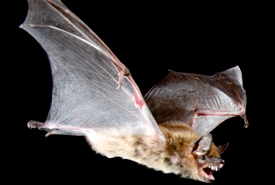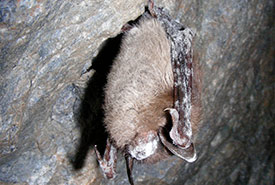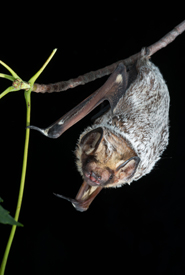What they do in the shadows

Big brown bat (Photo by Brock Fenton)
I love an underdog. I think it’s easy to fall in love with the quarterback or the frontperson in a rock ‘n’ roll band, but my heart has always belonged to the benchwarmer or the drummer. Growing up, while kids my age toted around their beloved teddy bears and stuffed rabbits, I gravitated toward the lesser known plushies from the roster of Canadian wildlife. My favourite, and the star player on my team, was a bat.
To this day, bats are like rockstars to me. They’re elusive, emerging during the night when the sun goes down and the stars come out to put on a show. Using impressive echolocation techniques, bats can communicate with one another, craft a flight route without accidents and detect flying insects for a midnight snack. Approximately 70 per cent of the global bat population (which totals over 1,400 species and counting) and all bats in Canada are insectivores. In fact, some bats can eat the equivalent of their body weight in flying insects every night, including hundreds of pesky mosquitos. There are also bat species that are important pollinators, helping produce some of the fruits we find in our grocery stores, including bananas and mangos. Some bats are frugivorous, and by feasting on fleshy fruits they help native plant species flourish by spreading their seeds through defecation during flight.

Little brown myotis exhibiting white-nose syndrome – note white fuzz on mouth and wings. (Photo by Marvin Moriarty)
Unfortunately, many bat species in Canada are declining. In Ontario alone, four of the eight species are considered endangered. There are many threats to bat populations globally. Here in Canada, the main threats to the 18 bat species are habitat loss and disturbance, pesticide use and white-nose syndrome. The latter of these threats is caused by a ruthless fungus that has been sweeping its way across Canada since 2010.
The Nature Conservancy of Canada (NCC) is combatting the threat of habitat loss by protecting habitat for bats across the country. One of the main habitats needed by bats in North America is forests. Some bats roost in dead or dying trees and others in living ones, and while some bats move from tree to tree, it is common for a bat or a whole colony to return to the same tree or area annually. Bats live in reciprocity with the forests by feeding on and protecting trees from destructive insects.

Hoary bat (Photo by Brock Fenton)
Across Canada, NCC is protecting nearly 1.2 million hectares forests, which are vital to the survival of bats. Species such as the little brown myotis (endangered), big brown bat and hoary bat all require forests to thrive.
Supporting species through restoring, maintaining and protecting their habitats for the long term is done best through collaboration. Since they are so elusive and sensitive to human disturbance, bat populations are often monitored over time to determine changes in their populations.
In Saskatchewan, NCC has conducted acoustic surveys on 18 different properties to build an inventory of the bat species present. From 2018 to 2022, NCC conducted a project to capture bats, affix radio transmitters and track them to their roost sites; this will help determine habitat use and roost site selection by bats in the mixed-wood forest of central Saskatchewan and inform NCC’s management of the properties in that area.
In BC, NCC has conducted bat detection surveys, participated in NA Bat (a North American grid-based survey), put up several types of bat boxes on the Frog Bear Conservation Corridor and is working with researchers to determine how to properly steward the project for threats to bats, such as the emergence of white-nose syndrome in the area.
In Quebec, NCC has located populations and hibernacula (winter hibernation sites) of little brown myotis on NCC properties in Quebec’s Green Mountains. In the Green Mountains, local conservation groups, including Granby Zoo and Appalachian Corridor, are working together to locate bats and promote their protection to the public. NCC has made several land acquisitions that contribute to their maintenance.
NCC is also working with the Toronto Zoo on their Native Bat Conservation Program, which involves monitoring bats in Ontario to learn more about their populations.
We need to bring bats centre stage to keep them from declining. Let’s make bats the star of the conservation show in Canada and beyond.


